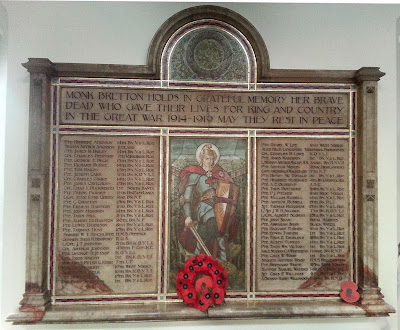 |
| Barnsley War Memorial in front of the Town Hall |
Since beginning this research in September I have found that war memorials began to be discussed during the war, for example the first mention I have found of a memorial in Cudworth is in January 1917, so I will need to amend my original search parameters to include the war years. I have, so far, searched through 1919-1921 and found hundreds of mentions of the topic of memorials in the Barnsley area. Opinions differed on what was the proper way of commemorating the men (and women) who had fallen. The widows of servicemen, especially those who lacked a grave to visit (no bodies were repatriated in the First World War, apart from the Unknown Soldier who was buried in Westminster Abbey) wanted a tangible site at which to mourn. Some returning service men suggested cottage hospitals, cottages for widows and disabled servicemen and others wanted a suitable memorial to remind future generations about the ultimate sacrifice made by their comrades. As a consequence of my research I become involved in the Barnsley War Memorials Project which hopes to co-ordinate the discovery, recording and research of any and all memorials in the Barnsley area.
 |
| Location of Monk Bretton to the North East of Barnsley (a 1920s Bartholomew's map from NLS) |
In the Barnsley Chronicle in February 1919 memorial windows were suggested for St Paul's church at Monk Bretton and at Smithies and Old Mill along with brass tablets inside the buildings and stone tablets outside. Two weeks later a letter to the Chronicle condemned this plan as a waste of money and suggested building houses instead and the debate continued through into March. It was suggested that photographs of the fallen men with their names and honours attached should be hung in Smithies Wesleyan Reform Chapel, Old Mill Chapel and Smithies Working Men's Club. One correspondent noted that "90% of the men who have gone were Non-Conformists" and objected to the sole memorial being in Monk Bretton Church.
 |
| Barnsley Chronicle 26 Mar 1921 (thanks to Barnsley Archives) |
In September 1919 an appeal appeared in the paper for names to be submitted for the memorial and then I note nothing more until a plaque is unveiled in June 1920 at Cliffe Bridge Wesleyan Chapel and then in March 1921 a Roll of Honour unveiled in Monk Bretton Working Men's Club. I wonder what was actually decided upon for Smithies and Old Mill?
Forty-nine names are mentioned in the newspaper article (left) printed in the Barnsley Chronicle on 26 March 1921. These were not just the seven who fell, but all members of Monk Bretton Working Men's Club who served. A list of the names can be seen here and on the Barnsley War Memorials Project. I don't know if this Roll of Honour still exists - can anyone help me?
The memorial in St Paul's Monk Bretton was unveiled on 22nd May 1921. It took the form of an large alabaster tablet with the figure of St George in the centre and the names of 61 one men and one woman were inscribed to either side. It was placed on the wall of the north aisle, where the OH and I were very pleased to see it yesterday afternoon. I spoke to the Vicar, Father Kevin Maddy, and asked if he knew of anyone who was already researching the names on the memorial. He wasn't aware of anyone so I offered my services. I have already researched one name, that of John Thomas Johnson who is a relative by marriage of the OH. His story can be found in one of my previous posts.
 |
| The memorial tablet in St Paul's church Monk Bretton |
A transcription of the names can be found here and on the Barnsley War Memorials Project.
Also in the church at Monk Bretton is a Memorial Book. This lists the same names as the memorial tablet and can be found in a glass case in a window at the back/west end of the church. Pictures of both the memorial plaque, the memorial book and many other pictures around the church plus memorial inscriptions from the churchyard can be found in a DVD published by the Barnsley Family History Society - and available from GenFair.
 |
| Monk Bretton War Memorial on Cross Street, Monk Bretton |
You might be wondering when I going to mention the War Memorial I visited some months ago on Cross Street, Monk Bretton. Well, it hasn't come up in the newspapers yet. Unhappily this means that the information for this memorial on the Imperial War Museum's War Memorials Archive is incorrect as it notes the unveiling of this memorial to be 22 May 1921, which I have just discovered is the date of the unveiling of the memorial in the church. I am sure that if this memorial was dedicated at the same time some mention would have been made in the newspapers, so I can only assume I must keep looking. The memorial lists casualties from both World Wars, however the dates 1914 and 1918 are carved into each pillar, suggesting it was originally erected to commemorate the First World War. The names on this memorial can be found on the Barnsley War Memorials Project.
I suppose that's what I like about all of my family and local history research, it often seems that no sooner have you solved one mystery than another appears. When I find the answer I'll let you know!

No comments:
Post a Comment